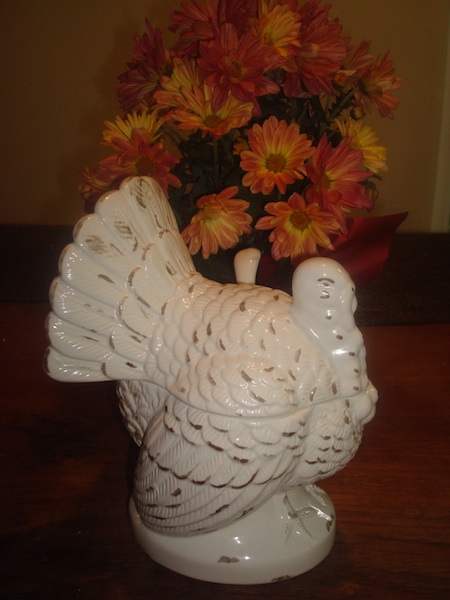While out on a walk last evening, I came upon the five wild turkeys that roam our neighborhood. As I stood there watching them waddle across the street in front of me, I thought, ‘What was it that drove us to make the turkey the official bird of Thanksgiving, because unless they are in full ‘bloom’ they’re just not very attractive.”
I guess hunger had a lot to do with it, because we all know that things were pretty bleak for the Pilgrims in those early years. Many died of starvation, so when the harvest in 1621 turned out to be a particularly abundant one, the surviving pilgrims celebrated with the native Wampanoag Indians, coming together for a three-day festival filled with food.
After the first Thanksgiving in 1621, it took over 200 years before Thanksgiving Day was officially proclaimed as a national day of thanksgiving, praise and prayer in 1863.
Now, we have no real evidence that turkey was served at the Pilgrim’s first thanksgiving, but it is believed that the feast contained some kind of fowl. (The pilgrims used the term ‘turkey’ to collectively refer to the chicken, hen, turkey and other fowl that roamed the land.) Regardless of the fowl that was consumed on that day, today’s modern day celebrations include the turkey.
As we all ready to sit down with family and friends and enjoy the day, you can be assured that the conversation will include comments such as: “Oh, that’s a wonderful turkey. How did you prepare it? Oh, the breast meat is so tender and juicy.” After all, the turkey is the centerpiece of the meal.
If it was turkey they consumed back in 1621, the comments were probably not the same. The wild turkey of those days was definitely different than those we know, and eat, today. Most likely, it was lean, dry and probably tough. Today, turkeys are bred to produce large breasts, which is often considered the prized portion of the bird. (Although drumstick eaters may beg to differ). The broad-breasted white (Think Butterball) is probably what most of us enjoyed growing up.
But now, the Butterball has come under scrutiny. With growing attention to the way our meat, poultry, fish and produce are produced, that standard “Butterball” might not be the bird of choice for everyone. It isn’t that my grandmother didn’t care about the turkey, it was simply what was available.
Today, choices are a bit more complicated, especially with the growing resurgence of the Heritage turkeys, which were driven to near extinction in 1990. While it may be too late to secure yourself a true Heritage turkey, here are some of the most common classifications that can be found on the turkey label to help you make your choice:
Fresh – Don’t be fooled by this term. I usually connote fresh to mean that it is “recently produced, obtained or arrived (Webster’s new world dictionary. I also equate fresh to mean, “Not spoiled, rotten or stale.” But, in the bird world, fresh means that turkey has never been kept below 26F. Under this definition, the bird could have been processed in October, even September and kept at, or above, 26 degrees F for months before turning up on your Thanksgiving table.
Frozen – It has been kept below 0 degrees F. Most likely, a frozen bird was raised in a barn with lots of other birds, and given antibiotics to increase its weight – then flash frozen to about -30 degrees F.
Which leads us to the question: Fresh or frozen?
The decision between the two can be based on cost and convenience, although a fresh turkey will tend to taste gameier than a frozen one, because of the fresh turkey’s natural diet. A fresh turkey will cost more, and it will need to be purchased within a day or two before consuming. A frozen turkey can be purchased weeks head of time (especially if you have room to store it). The frozen turkey can then be slowly defrosted in the refrigerator, giving it a day for every five pounds.
 Girl/Boy: Hen/Tom – Most will agree that there isn’t much difference in taste between a male and a female turkey, but when buying, consider that the male has a greater meat-to-bone ratio. Therefore figure about ¾ of a pound per person with a male, and about 1 lb per person for the female.
Girl/Boy: Hen/Tom – Most will agree that there isn’t much difference in taste between a male and a female turkey, but when buying, consider that the male has a greater meat-to-bone ratio. Therefore figure about ¾ of a pound per person with a male, and about 1 lb per person for the female.
Organic: The term is an assurance that the bird was fed organic feed, was free range, and has not been treated with antibiotics. To carry the seal, it must be certified by a USDA-accredited agency.
Natural: The term means that the turkey contains no artificial ingredients or added color. It also gives the assurance that they are minimally processed. However, the use of the term ‘natural’ doesn’t mean that it hasn’t been treated with antibiotics.
Free-range: This term means that the turkey has access to the outside, however, it does not necessarily mean the turkey took advantage of that offer and almost all poultry can be labeled free range.
Pasture-raised:
A term that provides a bit more assurance than the free-range definition. Pasture-raised, or pastured poultry, is a term that the American Pastured Poultry Producers’ Association has furthered in the past two decades. According to the Association, “the model allows the birds to receive a significant amount of pasture forage as feed. The birds are kept on fresh pasture, which allows the birds to be raised in a cleaner, healthier environment. Pastured poultry is raised the old fashioned way; on fresh green pasture and wholesome grain. Processing is often done on the farm. Many customers pick-up their freezer-ready poultry orders at the farm, assuring them a truly farm-fresh product and revitalizing the farmer-consumer relationship.”
Meat from pasture-raised turkeys tends to be dense (or lean), tender, juicy and flavorful due to the healthy environment in which they are raised.
Heritage: The ancestor to the broad-breasted white industrial turkey. Heritage breeds, often referred to as heirloom, are making a comeback, and include breeds such as the Standard Bronze, Bourbon Red, Jersey Buff, Slate, Black Spanish, Narragansett and White Holland. They all have rich tasting meat, which is very moist and flavorful. They have diverse diets and a life-span that is longer than the broad-breasted varieties that are bred for short life-span and big breasts.
The Heritage Turkey Foundation, “They are traditional standard breeds of turkeys which have not been industrialized for efficient factory production at the expense of flavor and the well-being of the turkeys”.
But, now that you’ve made the decision as to what kind of bird to put on the table (whether it is the Butterball or organic, free range, grass fed, heritage variety), now you can start planning all the delicious side dishes to accompany it. Following are a few of our favorite Thanksgiving sides. Enjoy.
Cranberry Compote with Ginger and Molasses






